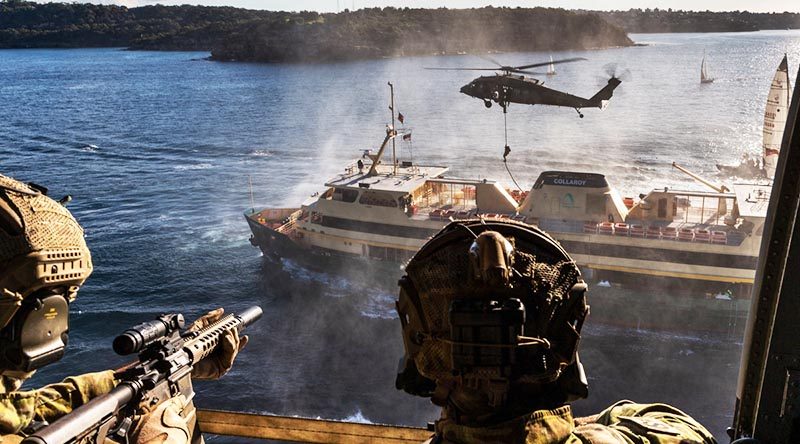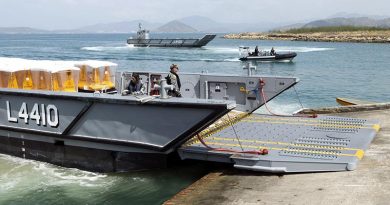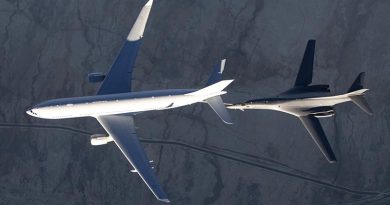Commandos storm Sydney ferry

Exercise MARS RAT readies counterterrorism group for any eventuality, writes Corporal Sebastian Beurich, in ARMY Newspaper edition 1446, 25 July 2019.
Aussie commandos ready for anything
Sailing through Sydney Harbour, the first sign things were amiss was the dull thump of helicopter blades, barely audible over the water rushing past the bow of the ferry.
CAPTION: Australian Army soldiers from 2nd Commando Regiment secure a Sydney ferry in Middle Harbour, New South Wales, during counter-terrorism training. Photo by Corporal Kyle Genner.
Seconds later, 2 Cdo Regt soldiers disembarked from RHIBs and were climbing over the side rails, while their comrades fast roped on to the deck from a hovering 6 Avn Regt Black Hawk, supported by snipers in another Black Hawk providing aerial fire support.
They stormed through the ferry, subduing all the threats they met along the way.
Within minutes they had the ferry under control, the threats neutralised and the hostages saved.
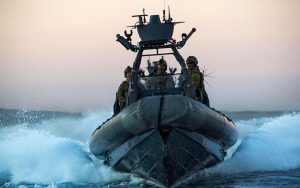
The scenario was part of Exercise MARS Rotor Anchor Toothfish (RAT), a key exercise for the Sydney-based Tactical Assault Group – East (TAG-E) – the ADF’s “in extremis” counterterrorism force drawn from 2 Cdo Regt.
Along with the maritime counterterrorism exercise on Sydney Harbour, MARS RAT also included a ship-at-anchor recovery of a large merchant vessel off Port Kembla, and a coordinated split assault on two linked strongholds: a high-rise in Melbourne’s CBD and shipping facility in Hobart.
Lead-up component and refresher training meant the 2 Cdo Regt soldiers were “fully versed” in the activity, according to Cpl B, who said increased access to training resources was great for the team.
“We moved TAG-E down to Melbourne for the high-rise scenario, with some of the team driving and others flying,” he said.
“From there we assaulted the building from both ends, utilising Black Hawks to get us on top, while other callsigns moved up through the building’s stairwells.
“This sort of training only happens once or twice a year, usually during these big exercises, but having real infrastructure to train on – like a high-rise building in the middle of Melbourne’s CBD – is a real benefit.”
The 2 Cdo Regt HR/CT (hostage recovery/counterterrorism) company that makes up TAG-E includes a RHIB boat team, commando assaulters, commando snipers, a dedicated medical team, and it’s supplemented by Navy clearance divers.
This mix of skills gives ground commanders many approach options, with Capt N saying the addition of up-skilled Navy clearance divers added to flexibility in the maritime domain.
“The exercise is really about consolidating our key domestic counterterrorism skills,” Capt N said.
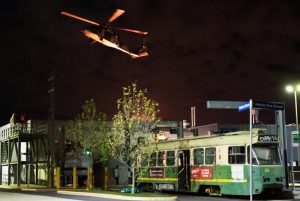
“Part of that is the maritime counterterrorism piece, where we have a remit out to 200nm.
We covered off on ship-alongside and ship-underway assaults, including subsurface approaches with our divers.
“We were also working on force projection, using helicopters to launch us into top-down assaults to achieve vertical envelopment and using RAAF assets to deploy interstate.
“2 Cdo Regt companies rotate onto HR/ CT duties on TAG-E every few years at the moment, so it’s a good opportunity for us to consolidate our core skills.
“I enjoy it thoroughly – having so many resources available means we’re able to conduct high-quality and the most realistic training.”
While MARS RAT gave the company an opportunity to hone their maritime counterterrorism and aerial insertion skills, it’s not the culmination of their training program.
Because of their unique mandate, they have to be prepared for any eventuality.
“TAG is basically the Australian government’s fix for any situation that is beyond the capability or capacity of the state police,” Pte R said.
Socomd also has TAG–West based in Perth.
“Once this exercise is done, then we’ll go through a number of other training scenarios – CBRNE and mass-casualty threats, as well as tubular assaults: planes, trains and tunnels,” Pte R said.
“I can put my hand on my heart and say the guys I work with are the best. You want to come to work every day and you want to push to achieve your goals because you’re with like-minded people.”
.
.
.
.
.
.

.
.

